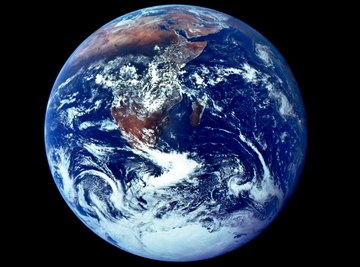
The Earth's atmosphere is unique within the solar system and plays an essential role in maintaining a hospitable environment for life. There are a number of distinct layers of the atmosphere, and these each play a role in regulating the Earth's internal environment. The main layers within the atmosphere are the troposphere, stratosphere, mesophere and thermosphere. The thickness of the atmosphere, depending upon the definition, is between 100 and 10,000 kilometers.
TL;DR (Too Long; Didn't Read)
The thickness of the atmosphere, depending upon the definition, is between 100 and 10,000 kilometers.
Troposphere Layer
The troposphere can be found between the ground and an altitude of 7 to 20 kilometers (4 to 12 miles). The lesser thickness is found at the polar regions, since colder temperatures lead to a decrease in gas volume. The vast majority of the world's weather is formed in the troposphere and this layer also contains 80 percent of the atmosphere's mass. The temperature within the troposphere drops with altitude, since it is essentially being warmed by the ground. The pressure also drops within the troposphere as altitude increases, and this explains why mountaineers require oxygen masks.
The Stratosphere
The stratosphere can be found between average altitudes of 20 and 50 kilometers (12 and 31 miles). The lower altitude of the stratosphere changes seasonally and varies between 8 and 16 kilometers (5 and 10 miles). The thickness of the stratosphere also varies with latitude. In both cases, colder regions and seasons lead to a thinner stratosphere, due to gas compression. Temperature and pressure increases with altitude in the stratosphere, and this stratification leads to more stable air where commercial jetliners can carry out the bulk of their journeys. The layer is also home to the important ozone layer that helps to protect biological organisms from ultraviolet radiation.
The Mysterious Mesosphere
The mesosphere can be found at altitudes between 50 and 85 kilometers (31 miles and 53 miles). This is the layer in which meteors burn up in the atmosphere, producing the distinctive streak known as a shooting star. Temperature and pressure decreases with increasing altitude within the mesosphere, and the lowest temperature -- -90 degrees Celsius (-130° Fahrenheit) -- in the Earth's atmosphere can be found at the top of the mesosphere. Apart from this, little is known about the mesosphere, as its high altitude makes its inaccessible to weather planes and balloons. Measurements tend to be performed using sounding rockets, which collect data as they travel through the mesosphere.
The Thermosphere and Outer Space
The thermosphere lays between 90 kilometers (56 miles) to 1,000 kilometers (621 miles) above the Earth's surface. Both temperature and pressure decrease with inreasing altitude within this layer. The air density in this region of the atmosphere is very low and the international space station, as well as other orbital satellites, circle the Earth within the thermosphere. This leads to the controversial discussion about where the Earth's atmosphere stops, and space begins. The official definition of space puts it at 100 kilometers above the Earth's surface. However, it should be noted that a further shell of gas surrounds the Earth. Known as the exosphere, it can be found between altitudes of 500 and 10,000 kilometers (310 to 6,213 miles).
References
About the Author
Samuel Markings has been writing for scientific publications for more than 10 years, and has published articles in journals such as "Nature." He is an expert in solid-state physics, and during the day is a researcher at a Russell Group U.K. university.
Photo Credits
Thinkstock Images/Comstock/Getty Images
